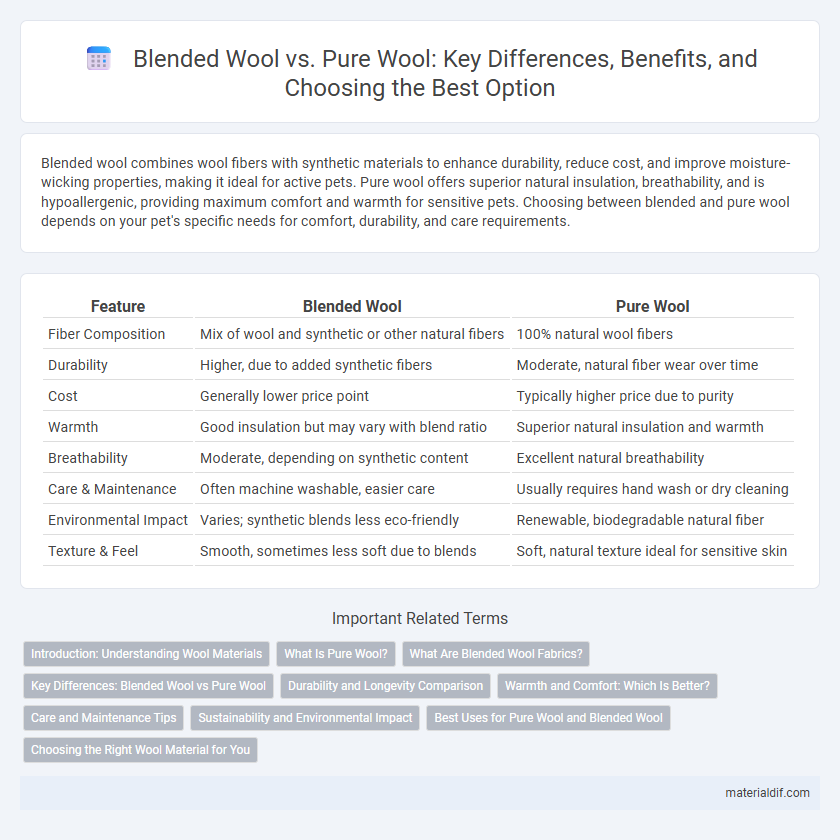Blended wool combines wool fibers with synthetic materials to enhance durability, reduce cost, and improve moisture-wicking properties, making it ideal for active pets. Pure wool offers superior natural insulation, breathability, and is hypoallergenic, providing maximum comfort and warmth for sensitive pets. Choosing between blended and pure wool depends on your pet's specific needs for comfort, durability, and care requirements.
Table of Comparison
| Feature | Blended Wool | Pure Wool |
|---|---|---|
| Fiber Composition | Mix of wool and synthetic or other natural fibers | 100% natural wool fibers |
| Durability | Higher, due to added synthetic fibers | Moderate, natural fiber wear over time |
| Cost | Generally lower price point | Typically higher price due to purity |
| Warmth | Good insulation but may vary with blend ratio | Superior natural insulation and warmth |
| Breathability | Moderate, depending on synthetic content | Excellent natural breathability |
| Care & Maintenance | Often machine washable, easier care | Usually requires hand wash or dry cleaning |
| Environmental Impact | Varies; synthetic blends less eco-friendly | Renewable, biodegradable natural fiber |
| Texture & Feel | Smooth, sometimes less soft due to blends | Soft, natural texture ideal for sensitive skin |
Introduction: Understanding Wool Materials
Blended wool combines natural wool fibers with synthetic or other natural materials, enhancing durability and reducing cost compared to pure wool. Pure wool consists entirely of 100% natural wool fibers, offering superior warmth, breathability, and softness. Understanding the differences in fiber composition is essential for selecting the appropriate wool type based on performance and comfort needs.
What Is Pure Wool?
Pure wool consists entirely of natural fibers sourced from sheep, offering exceptional warmth, breathability, and durability. Unlike blended wool, which combines wool with synthetic fibers to enhance elasticity or reduce cost, pure wool maintains its natural moisture-wicking and insulating properties. This makes pure wool ideal for high-quality garments and textiles requiring superior comfort and resilience.
What Are Blended Wool Fabrics?
Blended wool fabrics combine natural wool fibers with synthetic materials like polyester, nylon, or acrylic to enhance durability, elasticity, and cost-effectiveness. These blends improve resistance to wrinkles, shrinkage, and moisture, making them popular in garment manufacturing for suits, outerwear, and knitwear. Pure wool, derived entirely from sheep's fleece, offers superior insulation, breathability, and natural softness but lacks the increased strength and affordability of blended alternatives.
Key Differences: Blended Wool vs Pure Wool
Blended wool combines wool fibers with synthetic or natural materials, enhancing durability, stretch, and cost-effectiveness, while pure wool consists solely of natural wool offering superior breathability, insulation, and softness. The presence of synthetic fibers in blended wool improves wrinkle resistance and color retention, making it ideal for everyday wear and performance garments. Pure wool excels in moisture-wicking and temperature regulation, favored for high-quality suits, sweaters, and luxury textiles.
Durability and Longevity Comparison
Blended wool combines natural wool fibers with synthetic materials, enhancing durability and resistance to wear, making it more resilient for everyday use compared to pure wool. Pure wool offers natural breathability and softness but tends to be less resistant to abrasion, which may reduce its longevity under heavy use. Choosing blended wool extends garment lifespan through improved strength, while pure wool retains superior natural insulation and comfort qualities.
Warmth and Comfort: Which Is Better?
Blended wool combines natural wool fibers with synthetic materials, enhancing durability and moisture-wicking properties while maintaining considerable warmth and comfort. Pure wool offers superior insulation and breathability due to its natural lanolin content, providing exceptional warmth and softness ideal for cold environments. For optimal comfort and warmth, pure wool excels in natural temperature regulation, but blended wool can offer improved resilience and easier maintenance.
Care and Maintenance Tips
Blended wool, often mixed with synthetic fibers, requires gentle washing in cold water and low-heat drying to prevent damage and maintain fabric integrity, whereas pure wool demands hand washing or dry cleaning to avoid shrinkage and preserve softness. Both types benefit from air drying flat and storing with moth repellents to extend garment lifespan. Avoiding excessive friction and using wool-specific detergents enhance durability and appearance for blended and pure wool garments alike.
Sustainability and Environmental Impact
Blended wool, often mixed with synthetic fibers, tends to have a higher environmental footprint due to non-biodegradable components and more complex recycling processes. Pure wool is biodegradable, renewable, and contributes less to microplastic pollution, making it a more sustainable choice in textile production. Choosing pure wool supports lower carbon emissions and reduces landfill waste compared to blended alternatives.
Best Uses for Pure Wool and Blended Wool
Pure wool is ideal for high-quality garments like suits, sweaters, and scarves due to its superior insulation, breathability, and natural moisture-wicking properties. Blended wool, often mixed with synthetic fibers such as polyester or nylon, offers enhanced durability, wrinkle resistance, and affordability, making it perfect for everyday wear, work uniforms, and activewear. Choosing pure wool suits premium warmth and comfort, while blended wool provides practical benefits for long-lasting, easy-care clothing.
Choosing the Right Wool Material for You
Blended wool combines natural wool fibers with synthetic materials, enhancing durability and wrinkle resistance while maintaining some warmth and softness. Pure wool offers superior insulation, breathability, and moisture-wicking properties, making it ideal for natural comfort and temperature regulation. When choosing the right wool material, consider the balance between durability and natural fiber benefits based on your specific needs for comfort, maintenance, and wear longevity.
Blended wool vs Pure wool Infographic

 materialdif.com
materialdif.com